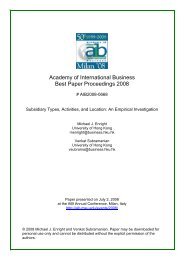AIB 2012 Conference Proceedings - Academy of International ...
AIB 2012 Conference Proceedings - Academy of International ...
AIB 2012 Conference Proceedings - Academy of International ...
Create successful ePaper yourself
Turn your PDF publications into a flip-book with our unique Google optimized e-Paper software.
MONDAY<br />
MNCs. (For more information, please contact: Heather K Berry, George Washington University, USA:<br />
berryh@gwu.edu)<br />
Building Effective R&D Portfolios: Location Choices and Performance Consequences<br />
Mario Kafouros, University <strong>of</strong> Leeds<br />
Niron Hashai, The Hebrew University<br />
Chengqi Wang, Nottingham University Business School<br />
Though R&D internationalization is central to organizational strategy, its consequences for firm performance<br />
remain less well understood, thus limiting scholarly theorizing about the forces shaping the success <strong>of</strong> overseas<br />
innovation. The current study is designed to address this lack <strong>of</strong> understanding. In contrast to single-location<br />
analyses, our conceptualization extends prior theorizing on the globalization <strong>of</strong> innovation by capturing firms'<br />
entire portfolios <strong>of</strong> R&D labs, their location choices in the global landscape, and differences in the resulting<br />
distribution <strong>of</strong> R&D labs. Our contribution lies in explaining how, and the extent to which, R&D portfolios enable<br />
MNEs to exploit globally dispersed location bound resources. Our analysis generates implications for theory,<br />
indicating that the effects <strong>of</strong> R&D on performance not only depend on the degree <strong>of</strong> its internationalization, but<br />
also on how it is internationalized. (For more information, please contact: Mario Kafouros, University <strong>of</strong> Leeds,<br />
United Kingdom: mk@lubs.leeds.ac.uk)<br />
Superstar Inventors in Foreign Subsidiaries <strong>of</strong> the MNC<br />
Katarina Blomkvist, Uppsala University<br />
Philip Kappen, Uppsala University<br />
Ivo Zander, Uppsala University<br />
This paper develops a micro-perspective on the geographical dispersion <strong>of</strong> technological renewal in foreign<br />
subsidiaries <strong>of</strong> the multinational corporation (MNC). We draw upon an original data set comprising 371 foreign<br />
subsidiaries <strong>of</strong> 21 Swedish MNCs and follow their patenting activity to document the distribution <strong>of</strong> inventive<br />
activity both across and within individual subsidiaries. Findings at the subsidiary level show that the distribution<br />
<strong>of</strong> technological activity and contribution to the overall multinational group is significantly skewed, and we<br />
proceed to empirically explore the assumption that a similar distribution applies also at the level <strong>of</strong> individual<br />
inventors. The results point to a pattern where most inventors make only occasional and limited technological<br />
contributions and more significant numbers <strong>of</strong> new technological discoveries are instead attributable to a select<br />
group <strong>of</strong> exceptionally inventive individuals. In the light <strong>of</strong> the results, we revisit the geographical distribution <strong>of</strong><br />
technological capabilities in the MNC, and suggest the fruitfulness <strong>of</strong> applying a people-centric perspective on<br />
the sources <strong>of</strong> sustained competitive advantage <strong>of</strong> the MNC, the management <strong>of</strong> geographically dispersed<br />
capabilities in the multinational network, and the geographical sources <strong>of</strong> invention in the MNC. (For more<br />
information, please contact: Katarina Blomkvist, Uppsala University, Sweden: katarina.blomkvist@fek.uu.se)<br />
Evolution <strong>of</strong> Global Innovation Network in MNEs<br />
Charles Dhanaraj, Indiana University<br />
Srivardhini K. Jha, Indian Institute <strong>of</strong> Management Bangalore<br />
Rishikesha T. Krishnan, Indian Institute <strong>of</strong> Management Bangalore<br />
Technological innovation is the cornerstone <strong>of</strong> competitive advantage –both for individual firms and for national<br />
economies. Advances in the institutional environment, and the changing dynamics <strong>of</strong> product and factor<br />
markets have systematically expanded the innovation networks <strong>of</strong> most multinational enterprises (MNEs) across<br />
the globe. As the innovation networks expand globally, achieving excellence or productivity in research and<br />
development (R&D) and ensuring appropriability <strong>of</strong> the innovation are the two major challenges for an MNE.<br />
While empirical research on MNE R&D has proliferated in recent years, theoretical development has been<br />
lagging significantly. Our paper fills this gap by addressing the central question in multinational R&D: How does<br />
an MNE's innovation network evolve Specifically, we draw on institutional and resource-dependence<br />
perspectives to extend the network model <strong>of</strong> MNE. We develop propositions to predict the onset <strong>of</strong> R&D<br />
mandate in a subsidiary, and the scope <strong>of</strong> the R&D function at a node, and the level <strong>of</strong> autonomy and<br />
<strong>AIB</strong> <strong>2012</strong> <strong>Conference</strong> <strong>Proceedings</strong><br />
Page 104

















